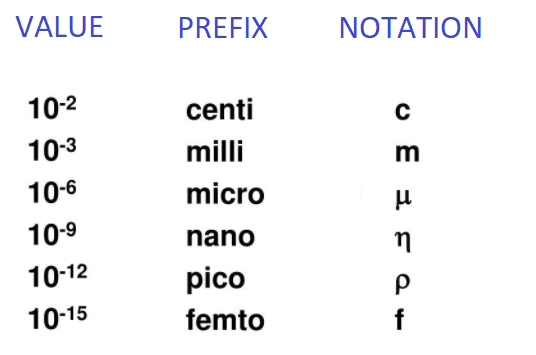
(A)
(B)
(C)
(D)
Answer
394.8k+ views
Hint: To measure the quantities we define a unit for them. Meter is a unit of length. We use scientific notations to write very small or very large numbers. Scientific notation is used when a number between
Complete answer:
We have a whole table of standard notations shown below in the picture.

A metric prefix is a unit that precedes a basic unit of measurement to indicate a multiple of the unit. All the metric prefixes used are decadic and each prefix has a unique symbol. They are very helpful, to write very large and very small measurements.
From the table, we can see that
Hence, the correct option is (A)
Note:
Very common metric prefixes are centi
A metric prefix is always followed by a SI unit.
To write the numbers in scientific notation, there are some rules.
-It is always written in base
-The value of the coefficient is (either positive or negative) of
-When we move the decimal to the left the power of
Complete answer:
We have a whole table of standard notations shown below in the picture.

A metric prefix is a unit that precedes a basic unit of measurement to indicate a multiple of the unit. All the metric prefixes used are decadic and each prefix has a unique symbol. They are very helpful, to write very large and very small measurements.
From the table, we can see that
Hence, the correct option is (A)
Note:
Very common metric prefixes are centi
A metric prefix is always followed by a SI unit.
To write the numbers in scientific notation, there are some rules.
-It is always written in base
-The value of the coefficient is (either positive or negative) of
-When we move the decimal to the left the power of
Recently Updated Pages
Master Class 9 General Knowledge: Engaging Questions & Answers for Success

Master Class 9 English: Engaging Questions & Answers for Success

Master Class 9 Science: Engaging Questions & Answers for Success

Master Class 9 Social Science: Engaging Questions & Answers for Success

Master Class 9 Maths: Engaging Questions & Answers for Success

Class 9 Question and Answer - Your Ultimate Solutions Guide

Trending doubts
State and prove Bernoullis theorem class 11 physics CBSE

What are Quantum numbers Explain the quantum number class 11 chemistry CBSE

Write the differences between monocot plants and dicot class 11 biology CBSE

Who built the Grand Trunk Road AChandragupta Maurya class 11 social science CBSE

1 ton equals to A 100 kg B 1000 kg C 10 kg D 10000 class 11 physics CBSE

State the laws of reflection of light




